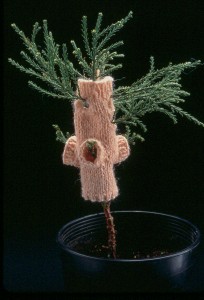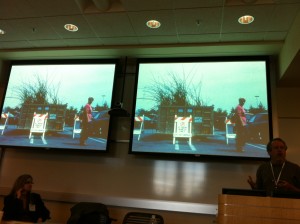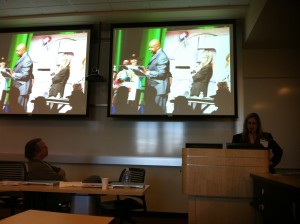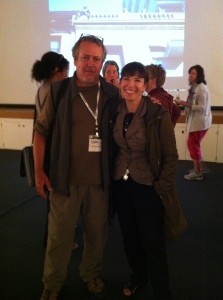At this year’s Association of Environmental Science Studies symposium, held at the University of Santa Clara, CA, it was my pleasure to present a talk titled Work Samples From the Field of Art and Science Collaborations. Also on the bill were Mark Brest van Kempen, Mary Rubin and Danielle Siembieda, all West Coast art professionals who are moving our collective awareness of environmental issues forward in a significant and dedicated manner.
The AESS panel focused on the state of the art, as it is being practiced, right now. One of the things that we can see in the current state of art and science collaboration is that the study of emergent properties in the fields of genomic engineering, AI and computer science, finds the pure sciences of today functioning a lot more like the applied sciences—in that they make something and then watch to see what it does—in much the same way that artists do. This, coupled with a recognition of the role the arts play in innovation, seems to have made scientific institutions, and scientists, increasingly receptive to working with artists. It is my personal desire to push this trend forward. I used to think that human industry was the greatest threat to the continuation of life on Earth as we know it, now I both believe and fear that it is our only hope.

The Hand Up Project, alternative housing for land hermit crabs by Elizabeth Demaray presented at AESS 2012
I began the Saturday after afternoon session with a brief sketch of a few projects that I have authored, that involve art and science collaboration. The first of these efforts is the Hand Up Project which focuses on creating alternative forms of housing for land hermit crabs. The second project, titled Corpor Esurit, or we all deserve a break today, explores the interconnected nature of our food chain and considers the plight of life forms the depend upon us humans, and by extension our industrial food production, for their sustenance. The third art piece I presented, Listening Stations for Birds, that play human music considers the nature of a biotope, that is an environment shared by multiple species, and the effect that different forms of human song production and presentation, may be having on our avian co-inhabitants. Lichen for Skyscrapers, the final project included in my talk, details my work culturing lichen on the sides of skyscrapers in NYC. I then addressed the challenges and rewards inherent in soliciting institutional support, dealing with the media and presenting work in this genera of art.
Mark Brest van Kempen, a Bay Area artist who creates artworks using the landscape itself as sculptural material, presented Ravenna Creek Project in Seattle, which brought together biologists, structural and civil engineers, and the community to create art tracing a creek as it passes under the city. He also presented a work in which he created a moving swampland–one parking space in size. In the piece, Brest van Kempen moved the “wetland” around from one shopping mall’s parking lot to another, complete with the signage pictured in the slid above.

Mary Rubin and Danielle Siembieda, project managers at San Jose Public Art Program and Zer01: Art & Technology Network, presenting The San Jose Climate Clock Initiative
Mary Rubin and Danielle Siembieda, project managers at San Jose Public Art Program and Zer01: Art & Technology Network, presented The San Jose Climate Clock Initiative in which they asked artists to create an iconic artwork that incorporates scientific measurement, data management, and communications technologies to increase the understanding of climate change while encouraging behavioral change necessary to reduce our collective carbon footprint. At AESS they presented the three finalist projects: Organograph (Geo Homsey, Chico McMurtrie and Bill Washabaugh); Silent Running (Robert Davis, Usman Haque and Caroline Lewis); and Wired Wilderness (Freya Bardell, Brent Bucknum and Brian Howe). In their deeply considered presentation on art, science and public art, they talked about the joys and pains inherent in bringing together media artists, climatologists, psychologists, physicists, statisticians, linguists, anthropologists, programmers, network engineers and industrial designers with the goal of to designing a 100 year-life iconic artwork in Silicon Valley.
Mary Rubin then concluded the panel with a presentation titled OPERATION PAYDIRT: A Creative Campaign for Change (a project directed by artist Mel Chin)” where she talked about her experience working as a project manager for the artist Mel Chen who’s PAYDIRT art work supports a solution to lead-contaminated soil in New Orleans and now in Oakland, CA. The aim of the piece is to end childhood lead poisoning. If lead poisoning leads to poor performance in the schools, learning disabilities, and juvenile delinquency, as all studies indicate, this project has the potential to counteract an environmental factor that contributes to undermining the health of society. Operation Paydirt expands upon a protocol currently used to successfully remediate highly polluted industrial and military sites. The Operation Paydirt methodology is being called Treat-Lock-Cover (TLC): Lead-contaminated soil will be treated with calcium phosphate, neutralized through the formation of complex minerals (pyromorphites) and then covered with three to six inches of clean sediments. Neutralized by calcium phosphate into stable mineral formations, lead is prevented from being absorbed into the bloodstream. This process, currently underway in Oakland CA, could also be of benefit to Camden NJ and other sites of industrial contamination.
In addition to organizing the panel and giving one of the presentations, I also got a “battlefield promotion” (this happens when you get a promotion, but are told not to lay down your weapon). Patricia Watts, founder and West Coast curator of Eco-Art Space, was slated to chair the panel and curate a show of eco-art related works for the AESS at the de Saisset Museum at Santa Clara University. Unfortunately, due to a death in her family she was unable to join us at the conference and I ended up chairing the panel with Mark Brest van Kempen and putting together an installation of visuals for the de Saisset. All my thanks to Jan Orvick and the staff at de Saisset Museum, I couldn’t have done it without their collective effort and infinite assistance.



